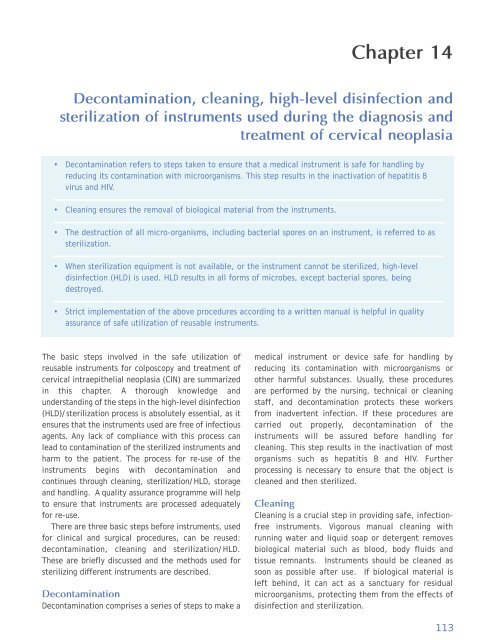Colposcopy and Treatment of Cervical Intraepithelial Neoplasia - RHO
Colposcopy and Treatment of Cervical Intraepithelial Neoplasia - RHO
Colposcopy and Treatment of Cervical Intraepithelial Neoplasia - RHO
Create successful ePaper yourself
Turn your PDF publications into a flip-book with our unique Google optimized e-Paper software.
Chapter 14<br />
Decontamination, cleaning, high-level disinfection <strong>and</strong><br />
sterilization <strong>of</strong> instruments used during the diagnosis <strong>and</strong><br />
treatment <strong>of</strong> cervical neoplasia<br />
• Decontamination refers to steps taken to ensure that a medical instrument is safe for h<strong>and</strong>ling by<br />
reducing its contamination with microorganisms. This step results in the inactivation <strong>of</strong> hepatitis B<br />
virus <strong>and</strong> HIV.<br />
• Cleaning ensures the removal <strong>of</strong> biological material from the instruments.<br />
• The destruction <strong>of</strong> all micro-organisms, including bacterial spores on an instrument, is referred to as<br />
sterilization.<br />
• When sterilization equipment is not available, or the instrument cannot be sterilized, high-level<br />
disinfection (HLD) is used. HLD results in all forms <strong>of</strong> microbes, except bacterial spores, being<br />
destroyed.<br />
• Strict implementation <strong>of</strong> the above procedures according to a written manual is helpful in quality<br />
assurance <strong>of</strong> safe utilization <strong>of</strong> reusable instruments.<br />
The basic steps involved in the safe utilization <strong>of</strong><br />
reusable instruments for colposcopy <strong>and</strong> treatment <strong>of</strong><br />
cervical intraepithelial neoplasia (CIN) are summarized<br />
in this chapter. A thorough knowledge <strong>and</strong><br />
underst<strong>and</strong>ing <strong>of</strong> the steps in the high-level disinfection<br />
(HLD)/sterilization process is absolutely essential, as it<br />
ensures that the instruments used are free <strong>of</strong> infectious<br />
agents. Any lack <strong>of</strong> compliance with this process can<br />
lead to contamination <strong>of</strong> the sterilized instruments <strong>and</strong><br />
harm to the patient. The process for re-use <strong>of</strong> the<br />
instruments begins with decontamination <strong>and</strong><br />
continues through cleaning, sterilization/HLD, storage<br />
<strong>and</strong> h<strong>and</strong>ling. A quality assurance programme will help<br />
to ensure that instruments are processed adequately<br />
for re-use.<br />
There are three basic steps before instruments, used<br />
for clinical <strong>and</strong> surgical procedures, can be reused:<br />
decontamination, cleaning <strong>and</strong> sterilization/HLD.<br />
These are briefly discussed <strong>and</strong> the methods used for<br />
sterilizing different instruments are described.<br />
Decontamination<br />
Decontamination comprises a series <strong>of</strong> steps to make a<br />
medical instrument or device safe for h<strong>and</strong>ling by<br />
reducing its contamination with microorganisms or<br />
other harmful substances. Usually, these procedures<br />
are performed by the nursing, technical or cleaning<br />
staff, <strong>and</strong> decontamination protects these workers<br />
from inadvertent infection. If these procedures are<br />
carried out properly, decontamination <strong>of</strong> the<br />
instruments will be assured before h<strong>and</strong>ling for<br />
cleaning. This step results in the inactivation <strong>of</strong> most<br />
organisms such as hepatitis B <strong>and</strong> HIV. Further<br />
processing is necessary to ensure that the object is<br />
cleaned <strong>and</strong> then sterilized.<br />
Cleaning<br />
Cleaning is a crucial step in providing safe, infectionfree<br />
instruments. Vigorous manual cleaning with<br />
running water <strong>and</strong> liquid soap or detergent removes<br />
biological material such as blood, body fluids <strong>and</strong><br />
tissue remnants. Instruments should be cleaned as<br />
soon as possible after use. If biological material is<br />
left behind, it can act as a sanctuary for residual<br />
microorganisms, protecting them from the effects <strong>of</strong><br />
disinfection <strong>and</strong> sterilization.<br />
113
















